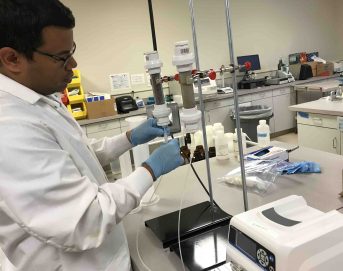Bioretention soil media being tested to compare effectiveness at treating stormwater

SCCWRP and its partners in October launched a year-long project to test the performance of six types of bioretention soil media designed to remove pathogens, indicator bacteria, nutrients, metals and other contaminants from stormwater runoff.
SCCWRP’s goal is to identify for Southern California stormwater managers the most cost-effective and efficient bioretention soil media to install in BMPs for improving the quality of stormwater runoff.
The media, which are intended to be placed in stormwater BMPs (best management practices) such as bio-swales and treatment wetlands, will be bench-scale tested in a SCCWRP laboratory prior to field-scale testing. Bench-scale testing utilizes 9-inch columns packed with various bioretention soil media types through which stormwater runoff will be pumped.
The SCCWRP laboratory setup is designed to mimic much larger biofiltration units that are constructed in areas such as parking lots to filter stormwater runoff on site.
The media types being tested include three types of biochar, which are particles created by pyrolyzing biomass materials such as wood at high heat with no oxygen – a process that results in no atmospheric carbon dioxide emissions. Researchers also will explore using biofilter media created from wastewater treatment sludge, which could provide an environmentally friendly reuse option for SCCWRP’s wastewater treatment member agencies.
Bioretention soil media remove stormwater contaminants through a combination of physical and chemical processes, including absorption, straining and biodegradation.
More news related to: Runoff Water Quality, Stormwater BMPs